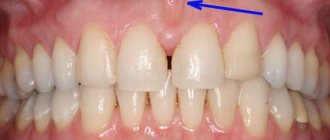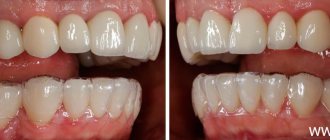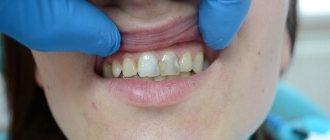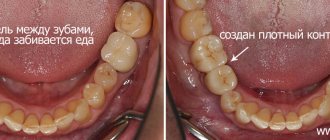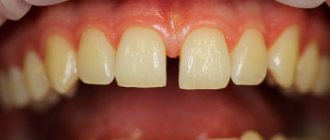Halitosis or bad breath is a symptom of pathological processes occurring in the body.
According to statistics, in 80% of cases, the cause of halitosis is dental problems, 10% are diseases of the ENT organs, and 10% are diseases of internal organs.
Having felt an unpleasant odor coming from their mouth, people most often turn to a dentist for advice. Often, upon examination, it is discovered that the source of the stale smell is a tooth rotting under the crown.
The main reasons why a tooth under a crown begins to smell bad
Wearing a prosthesis longer than expected . Over time, when wearing a denture for a long time, the gum tissue atrophies, and the area of the neck of the tooth is exposed. A loose connection of the crown to the gum causes the formation of a gap into which food debris gets trapped. It is impossible to remove accumulated substrate from under the crown using traditional methods: toothbrush, rinsing. As a result, an environment favorable for the growth of bacteria is formed under the crown, which in the course of their life emit foul-smelling sulfur dioxide gases.
Violation of the seal between the crown and the tooth . The reason is most often the incorrect installation of the prosthesis or the resorption of the material that was used to fix the artificial crown to the supporting tooth. Pathogenic microflora, penetrating into the formed cavities, causes secondary caries and inflammation of the gums.
If the crown is metal-ceramic, then under the influence of salivary secretions and oxygen in the air, the metal in its composition undergoes oxidation, which causes an unpleasant odor. In addition, the resulting oxides irritate the mucous membranes of the gums and can provoke allergic reactions.
Lack of tooth protection after grinding . One of the stages of preparation for prosthetics is preparation - removal of the enamel coating, which protects tooth tissue from mechanical damage and the action of microbes. If, before installing a permanent prosthesis, the ground tooth is not covered with a temporary crown or treated with cement, then bacteria settle on it and continue their destructive activity under the prosthesis.
Violation of the technological process of manufacturing and installing a prosthesis . If a crown is installed incorrectly, regardless of the reason (insufficient experience of dental technicians and orthopedists, use of low-quality materials), soft tissue injury occurs, followed by infection and the development of inflammation.
Poor oral hygiene . Artificial structures - dentures require special care and cleaning. If you neglect the rules of hygiene, pathogenic microorganisms begin to actively multiply, causing putrefactive processes.
Poor quality dental treatment . One of the main conditions for successful prosthetics is the absence of infection in the oral cavity. If teeth that are subject to prosthetics have a defect in filling the dental canals, a granuloma or cyst filled with pus may form at the apex of the root.
When teeth affected by caries appear under the crown, the decay process continues and ends with complete destruction and death of the tooth.
Common causes
There are many causes of halitosis; the main cause can only be determined by a dentist. The most common are:
- Poor oral hygiene. Failure to brush your teeth in a timely manner or the absence of an irrigator and dental floss in your daily care routine results in pieces of food remaining between the teeth. As the particles decompose under the influence of bacteria, they begin to emit a fetid odor of rotting.
- Infectious diseases of teeth and gums . If caries is not treated in a timely manner, processes of tissue decomposition begin inside the tooth, which causes a pungent odor. Stomatitis caused by fungus or periodontal disease also leads to necrosis of oral tissue.
- Smoking and alcohol increase gum disease
- Dry mouth caused by the use of certain medications or regular public speaking.
- Liver and kidney diseases, diabetes mellitus - these diseases are also precursors of unpleasant odor.
If there are no serious health problems, the carious cavities are healed, but the smell on the thread is still present, then the reasons may be the following:
- Poorly installed crowns and dentures . Food can accumulate in the spaces between the gum and the crown, which, if not properly hygienic, causes a stench.
- Accumulated tartar , which is chosen by anaerobic bacteria for their vital activity.
- Long-term use of antibacterial drugs and abuse of pastes and liquids with antibiotic effects.
Most of these problems can be resolved with regular visits to the dentist. To restore the microflora, you need to take medications prescribed by your doctor (Hilak-Forte, Linex-Forte) and increase your fluid intake.
Symptoms of tooth decay under the crown
The first sign of an inflammatory process under a prosthesis is not pain, as many people think, but an unpleasant odor. This happens because at the stage of preparation for prosthetics, the tooth is usually depulped, that is, the neurovascular bundle, which is responsible for sensitivity, is removed.
- An unpleasant taste first appears in the mouth, then a putrid odor is added, which cannot be masked by any chewing gum or mouthwash.
- The patient discovers a gap between the crown and the gum, where food debris gets in, which becomes a breeding ground for microbes.
- Often, inflammation of the gums develops near the tooth with the formation of soft tissue swelling.
- If the tooth has not been pulped, then severe pain is present.
- Blackening of the tooth under the crown.
All these symptoms indicate an advanced putrefactive process in the tooth covered with a crown. You should immediately seek medical help from a dentist.
Ignoring the problem leads to dire consequences:
- formation of a purulent cyst at the apex of the root;
- complete tooth destruction;
- the formation of periostitis or gumboil;
- spread of purulent infection along with blood or lymph flow to other organs.
When a visit to the dentist should be urgent
The appearance of an unpleasant odor from under dental structures is accompanied by additional symptoms. There is no need to delay your visit to the doctor.
Reasons to urgently consult a doctor:
- Mobility, complete or partial destruction of the crown.
- Pain – sharp, dull, aching, shooting, when biting, when brushing teeth, when exposed to thermal irritants.
- Change in gum color - hyperemia, cyanosis, swelling.
- Suppuration from under the crown, gums, formation of fistula tracts.
- Recurrent episodes of sinusitis.
- Numbness of the tongue, strange taste in the mouth.
- General weakness, fever, enlarged lymph nodes.
- Formation of a galvanic couple due to different prosthetic materials. Accompanied by a metallic taste in the mouth and electrical impulses.
But even if nothing besides amber bothers you, then consult a dentist. A bad odor indicates the proliferation of bacterial flora. And the appearance of pain or pus is a matter of time.
Why does the taste of blood appear in the mouth?
Inflammation of the gums under the denture is manifested not only by a specific smell from the mouth, but also by the appearance of a blood taste.
Inflammation of the gums around the crown is called gingivitis. Often the cause of gingivitis is rubbing of the mucous membrane due to the irregular shape of the prosthesis. For example, when the lower edge of the crown extends too deeply behind the gum, which leads to injury and bleeding. Blood is an excellent breeding ground for pathogenic microbes that readily multiply, causing inflammation of the soft tissue around a tooth with a poorly fitting denture.
Broken prosthesis that goes unnoticed. The bridge structures scratch the mucous membrane, leaving cuts and abrasions on it.
Bleeding is also the result of poor-quality tooth treatment before prosthetics. Against the background of inadequate filling of the dental canals or incomplete removal of the pulp, pathogenic microbes inside the tooth provoke a purulent process, which is accompanied by tissue destruction with the release of blood.
What to do to get rid of the smell
Some patients, even having discovered that the cause of such bad breath was a tooth rotting under the crown, for some time they hope to cope with the problem on their own: they rinse their mouth with decoctions of chamomile, calendula, and sage.
Antibacterial rinses and traditional medicine give a temporary effect and are not able to eliminate the root cause of the problem. In addition, frequent rinsing can disrupt the normal microflora of the oral cavity, when beneficial microorganisms die along with harmful ones.
It should be understood that no home remedies will stop the inflammatory process in the tooth, which will only progress and lead to its complete destruction and loss.
Treatment tactics vary and depend on the following factors:
- stages of tooth decay;
- the degree of spread of the inflammatory process to soft tissues;
- condition of root canals.
Treatment options for a tooth under a crown:
If the tooth stump has been preserved and has not undergone a carious process, the layers inside the crown are cleaned and, depending on the condition, it is either replaced with a new one or returned to its place after restoration.
When the upper part of the tooth is destroyed, but the roots are healthy, the stump inlay method is used. This is an orthopedic structure with “legs” that are fixed in the canals of the tooth, and an artificial crown is installed on top.
If the putrefactive process has gone too far and the tooth is completely destroyed, it is removed. As a rule, with long-term inflammation, the soft tissues surrounding the problematic tooth also suffer. Therefore, before proceeding with prosthetics, periodontitis is treated. There are two ways to restore a lost tooth: implantation or a bridge.
When choosing a dental clinic where you plan to get dentures, be sure to find out whether the medical institution provides guarantees for the treatment performed. If damage to the prosthesis occurs during the warranty period due to a medical error, treatment and restoration of the orthopedic structure is carried out free of charge.
How to treat unpleasant odor from under a crown
At the initial stage of treatment, the doctor must identify the reasons for the appearance of a bad odor from under the dental structure. Diagnostics includes:
- Examination of the oral cavity.
- X-ray of the tooth, according to indications - maxillary sinuses, orthopantomogram.
- Development of a patient management plan.
Based on the examination results, the doctor will suggest therapeutic or surgical treatment. You may need to consult a periodontist or otolaryngologist.
What the dentist can offer:
- Treatment of caries, sanitation of dental canals with their subsequent filling.
- In case of inflammation of the gums, the doctor will evaluate the quality of the installation of the prosthesis and the depth of the periodontal pockets. Their cleaning, rinsing with antibacterial solutions, and applications with medications are indicated. In severe cases, the doctor will prescribe antibiotic injections. After stopping the inflammatory process, physiotherapy is indicated for the mineralization of bone tissue.
- Installation of a new prosthesis - if the old crown cannot be restored, was installed with errors, or the patient has developed an allergy to the materials from which it is made.
- If tooth root cysts are identified, then their removal is indicated. Access is through an incision in the gum. The tooth can be saved.
- If perforation of the maxillary sinus is detected, the implant is removed. The sinuses are sanitized by an otolaryngologist. After stopping the inflammatory process, the bone tissue is restored, the bottom of the maxillary sinus is raised and a new implant is installed.
And most importantly! If a medical error has been made, self-respecting clinics provide treatment under a guarantee. Implantation, installation of crowns, dental structures are expensive services. And if the clinic does not provide a guarantee for its work, then you need to change the medical institution.
Additionally, conservative therapy is indicated - rinsing with decoctions of medicinal herbs, antibacterial drugs, training in the rules of oral care.
What to do if the tooth under the crown has completely rotted
One type of reconstruction of a severely damaged tooth is a stump inlay. It is a product that replicates the root system of the tooth. A crown is placed on the upper part of the structure protruding above the gum. The method is used only if there are healthy, undamaged roots.
Stump inlays are made of chrome-plated cobalt or alloys with precious metals (gold, silver). Preference is given to gold, as its shade resembles the color of natural enamel. The silver tab, despite its antibacterial effect, is used less frequently, since it shows through the crown as a dark spot.
If the roots are completely rotten and cannot be restored, the tooth is removed.
The choice of one or another method of dentition restoration in case of tooth loss remains with the patient, and his wishes regarding the material, type of structure, as well as financial capabilities are taken into account.
What to do if a crown falls off
The reasons why a crown falls off a tooth can be very diverse:
- With prolonged use, the cement on which the crown was strengthened dissolves.
- Secondary caries, leading to the destruction of the tooth stump and a violation of the tightness of the connection between the tooth and the crown.
- Damage to the denture due to heavy load when chewing solid food.
You cannot try to put the crown in its original place on your own and continue to use the prosthesis. This is very dangerous, since the crown, unexpectedly jumping off the tooth, can enter the windpipe and cause suffocation.
It is impossible to properly strengthen the prosthesis at home; only a dentist can do this.
The dentist, after examination and diagnosis, will decide what to do next.
There are several options:
- If the crown is only slightly damaged, it can be repaired and replaced.
- In case of significant damage or if the service life of the orthopedic structure has come to an end, the prosthesis must be replaced.
- If the cause of crown loss is caries, the tooth is treated, and then a decision is made about the possibility of prosthetics.
- If a tooth is severely damaged and cannot be restored, it is removed, and then implantation or a bridge is installed.
Rules for caring for fixed dentures
High-quality care of crowns in compliance with all hygienic rules can significantly extend the service life of the product.
Since a regular toothbrush is not able to fully clean all hard-to-reach places, additional care products are used to better treat teeth and dentures.
Dental floss (floss). This is a special thread made of nylon, silk, acetate fibers with a flat or round cross-section, designed to clean interdental spaces. To enhance the effect, they are often impregnated with antiseptics.
Floss - disposable toothpicks with a thread on a frame are used for the same purposes as floss.
Bundle brush . The interdental spaces are cleaned using a brush-brush with many long bristles. Dentists recommend alternating cleaning the spaces between teeth with brushes and dental floss, since some of them (floss) are better suited for narrow gaps, and a tuft brush does an excellent job of cleaning wide gaps.
An interproximal brush with a brush is designed to treat hard-to-reach areas between the crown and adjacent teeth.
An irrigator is a device for cleaning the oral cavity using a water jet supplied under pressure. A pulsating stream of water penetrates into the most inaccessible places, cleanses the surface of teeth and artificial dentures from plaque and food debris in the gum pockets and interdental spaces.
Dentists do not recommend using wooden toothpicks at all. Wood particles get stuck between the teeth, begin to rot and cause inflammation. In addition, toothpicks can easily injure your gums without even noticing it.
Causes of food getting stuck between teeth
The main reason for food getting between the teeth is a violation of the density of their contact with each other (in dentistry this concept is referred to as a “contact point”), which can be caused by:
- low-quality fillings (prostheses). An incorrectly placed filling may not exactly follow the topography of the tooth and may have an overhanging edge. A sign of poor quality fillings can be either stuck food or breaks in the dental floss during its use;
- natural structure of the dentition. This may be curvature of the teeth, diastema (gaps between the lower or upper central teeth), trema (gaps between the lateral teeth);
- deformation of the dentition due to injury, tooth extraction, and various diseases of the oral cavity.
- Unprofessional prosthetics. There may be a gap between the crown and the tooth; the denture design does not correspond to the anatomical shape.
- There is no papilla between the tooth and gum. It fills the interdental space, and in the absence of such a papilla, the problem of food getting stuck appears.
- Crevices. May appear as a result of injuries or diastema. As a result, pieces of hard food constantly get stuck in the cracks, which have to be removed with thread or a toothpick.
- Loss of teeth. As a result, the integrity of the dentition is compromised, which provokes the occurrence of the problem in question;
- Caries. As a result of carious lesions, the enamel is destroyed and a cavity is formed. Residues of food accumulate here, which can only be removed purposefully: ordinary rinsing and salivation will not cope with this task.
Preventive crown care
The prosthesis installed in the mouth is influenced by food chemicals, saliva, and microbes. Without systematic proper care of crowns, they become covered with plaque, lose their original color, and become a breeding ground for infection.
Prevention of the development of infection in the oral cavity, especially under fixed dentures, involves strict adherence to the following hygiene rules:
- Teeth should be brushed at least 2 times a day: morning and evening, and if possible, more often. Brushing technique: movements of the toothbrush are performed from the gum to the top of the tooth at an angle of 45°. The procedure time is at least 3 minutes.
- Rinse your mouth with clean water after every meal.
- For better cleaning of teeth and dentures, it is recommended to actively use additional devices: interproximal and tuft brushes, dental floss.
- Use irrigators. To rinse the oral cavity, various agents with an antibacterial effect are used that destroy pathogenic microorganisms.
A well-installed prosthesis with good care will reliably and for a long time protect the tooth from external factors. But if a tooth infection does occur and decay begins, without proper treatment the pathological process will only progress, which will lead to serious complications. To eliminate the consequences, long-term treatment with significant financial costs will be required.
Halitosis (bad breath)
Halitosis, or bad breath, is a very common condition. Depending on the cause, bad breath can be periodic or constant. In most cases, the main cause of halitosis is the millions of bacteria that live and multiply in the oral cavity. The temperature and humidity of the oral cavity create ideal conditions for the growth and reproduction of bacteria.
Some types of halitosis, for example, “morning breath,” when bad breath is noticed immediately after waking up and disappears after about half an hour, are considered normal and are not associated with various diseases. “Morning breath” appears due to the fact that during the day, abundant salivation rids the mouth of most decaying food debris, and at night during sleep, saliva is released in much smaller quantities, so nothing prevents bacteria from using food debris and dead cells in the mouth as food. food and release substances with an unpleasant odor in the process of vital activity.
In addition, the appearance of bad breath can be caused by the following reasons:
- Poor oral hygiene –
If you brush and floss irregularly or incorrectly, food particles can become trapped between teeth and along the gum line and then decay in the mouth. - Oral infections -
periodontal diseases. - Respiratory infections -
infectious diseases of the nasopharynx, respiratory tract, lungs. - External agents are
strong-smelling foods, such as garlic, onions, coffee, as well as smoking cigarettes and chewing tobacco. - Dry mouth (xerostomia) -
can be caused by salivary gland dysfunction, medications, or mouth breathing. - Systemic diseases -
diseases of the liver, kidneys, lungs, diabetes and others. - Mental illness -
Some people may feel like they have bad breath, but this is not noticed by oral health professionals or others around them. This phenomenon is called “false halitosis.”
Symptoms
A person does not always know that he has bad breath. This happens because the cells of the olfactory epithelium, which are responsible for recognizing odor, gradually get used to the constant bad breath, and the person does not notice it. Other people may smell bad and move away from you when you speak.
Symptoms of halitosis depend on the cause of its occurrence:
- Poor oral hygiene -
a film or soft plaque is noticeable on the teeth, food debris gets stuck between the teeth, the gums are pale or swollen. - Infections in the mouth—
gums may be red, swollen, and bleed, especially after brushing or flossing; Pus may leak between the teeth; the formation of a purulent abscess (abscess) in the oral cavity; teeth become loose or the “attachments” of the denture change; painful open sores on the tongue or gums. - Respiratory tract infections—
redness of the throat, enlarged lymph nodes in the neck (“sore tonsils”), fever, nasal congestion, greenish or yellowish nasal discharge, cough producing sputum. - External agents -
yellow-brown cigarette stains on the fingers and teeth, a uniform yellow coffee stain on the teeth. - Dry mouth -
difficulty swallowing dry foods, difficulty speaking for a long period due to dry mouth, burning sensation in the mouth, multiple dental caries, dry eyes. - Systemic diseases -
diabetes, kidney, liver, lung and others.
Diagnostics
A dentist or physician can diagnose halitosis by talking with the patient. Depending on the nature of the patient's breath, the dentist can suggest the cause of halitosis. For example, fruity breath may be a sign of diabetes. Breath that smells like urine can in some cases indicate kidney disease.
Tell your dentist if you are taking medications that may cause dry mouth and halitosis. Also tell your dentist about your diet, personal habits (smoking, chewing tobacco), who noticed your bad breath and under what circumstances.
The dentist will examine the teeth, gums, soft tissues of the mouth and salivary glands. The dentist will analyze your breathing as you exhale through your nose and through your mouth. After an examination, your dentist may refer you to a general practitioner if he or she believes the most likely cause of halitosis is a systemic disease. If your periodontal disease is severe, your dentist may recommend that you consult a periodontist (a dentist who specializes in periodontal disease).
If you suspect diabetes, lung infection, kidney disease, liver disease, you will need to get tested. Depending on the possible disease, these tests may include blood, urine, chest or sinus x-rays, or other tests.
Duration
How long it takes to get rid of bad breath depends on the cause of halitosis. For example, if the problem is due to poor oral hygiene, then with proper oral care, positive results will appear after just a few days of regular brushing with toothpaste, brushing and flossing. Don't forget to use mouthwash. Bad breath due to chronic sinusitis can be a recurring problem.
Bad breath due to systemic diseases can be an ongoing problem, which in most cases can be controlled with proper medical care.
Prevention
Prevention of halitosis, which is caused by improper oral hygiene, consists of daily compliance with the recommendations for brushing your teeth, tongue and gums after each meal, using mouth rinse and dental floss to clean the interdental spaces, approved by the Dental Association of Russia (StAR). Regular visits to the dentist (at least twice a year) for examinations and professional teeth cleanings.
You can also combat bad breath by drinking plenty of water to promote salivation. Rinsing your mouth with water can flush out food debris from your mouth. Foods that keep your breath fresh and can help prevent plaque buildup include sugar-free candy, raw carrots, celery, and others.
When to call a professional
Contact your dentist as soon as possible if you have bad breath accompanied by pain, swollen and/or bleeding gums, or loose teeth. Also see your doctor if you have halitosis accompanied by fever, red throat, nasal discharge, clear nasal discharge, or cough with phlegm. Even if you don't have these symptoms, contact your dentist or physician if you experience bad breath despite proper diet and oral hygiene.
If you have diabetes, gastrointestinal disease, or chronic kidney and/or liver disease, ask your doctor if bad breath could be a sign of your deteriorating health.
